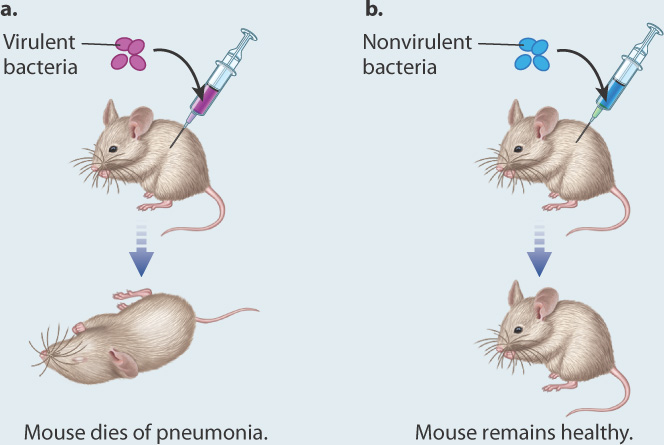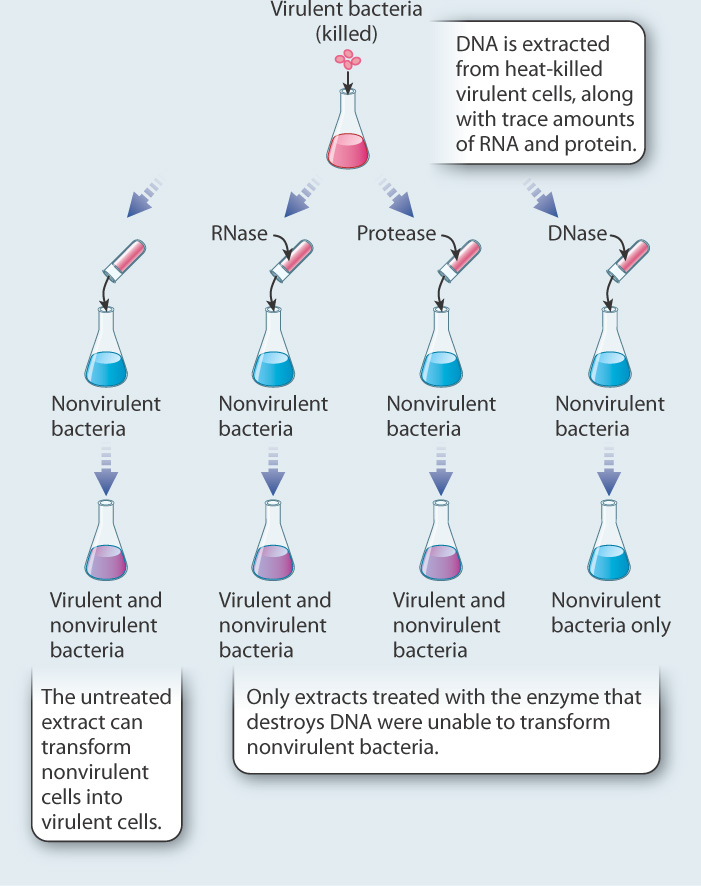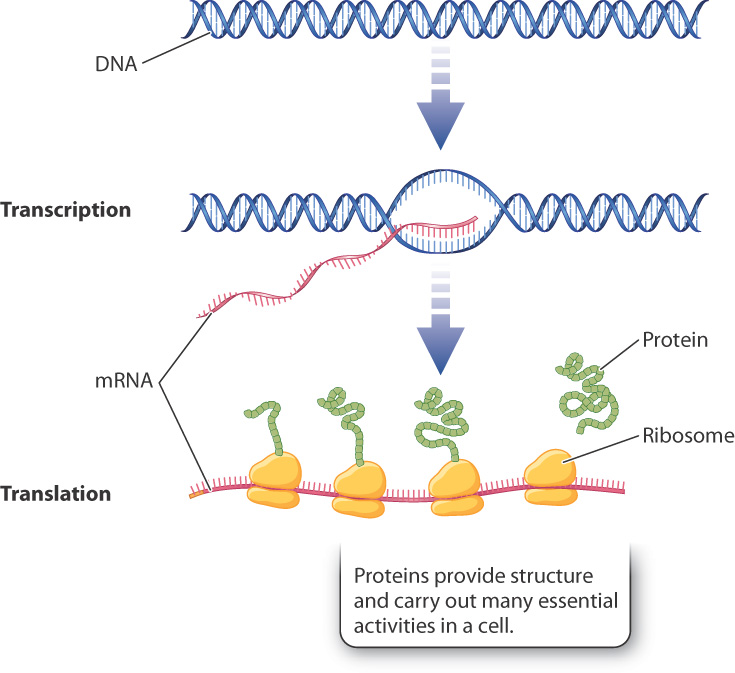3.1 MAJOR BIOLOGICAL FUNCTIONS OF DNA
DNA is the molecule by which hereditary information is transmitted from generation to generation. Today the role of DNA is well known, but at one time hardly any biologist would have bet on it. Any poll of biologists before about 1950 would have shown overwhelming support for proteins as life’s information molecule. Compared to the seemingly monotonous, featureless structure of DNA, the three-dimensional structures of proteins are highly diverse. Proteins carry out most of the essential activities in the life of a cell, and so it seemed logical to assume that they would play a key role in heredity, too. But while proteins do play a role in heredity, they play a supporting role in looking after the DNA—rather like the way worker bees are essential in maintaining the queen bee, who alone is able to reproduce.
3.1.1 DNA can transfer biological characteristics from one organism to another.
The first experiments to demonstrate that molecules can transfer genetic information from one organism to another were carried out in 1928 by Frederick Griffith, working with the bacterium Streptococcus pneumoniae. This organism causes a variety of infections in humans and a deadly form of pneumonia in mice. In the original experiments, illustrated in Fig. 3.1, Griffith studied two strains of the bacterium, one a virulent strain that caused pneumonia and death in injected mice and the other a mutant, nonvirulent strain that allowed injected mice to survive. When the debris of dead virulent cells was mixed with nonvirulent cells, some of the nonvirulent cells became virulent. Griffith concluded that some type of molecule in the debris carried the genetic information for virulence, but he did not identify the molecule.
FIG. 3.1: What is the nature of the genetic material?
BACKGROUND In the 1920s, it was not clear what biological molecule carries genetic information. Fred Neufeld, a German microbiologist, identified several strains of the bacterium Streptococcus pneumoniae, one of which was virulent and caused death when injected into mice (Fig. 3.1a), and another which was nonvirulent and did not cause illness when injected into mice (Fig. 3.1b).

EXPERIMENT Frederick Griffith was also a microbiologist interested in bacterial virulence. He made a puzzling observation. He noted that nonvirulent bacteria do not cause mice to get sick (Fig. 3.1b) and killed virulent bacteria do not cause mice to get sick (Fig. 3.1c), but when the two were mixed, the injected mice got sick and died (Fig. 3.1d). Furthermore, when he isolated bacteria from the dead mice, they had the appearance of the virulent strain, even though he had injected nonvirulent bacteria.
RESULTS

CONCLUSION One strain of bacteria (nonvirulent) can be transformed into another (virulent) by an unknown molecule from the virulent cells. In other words, the unknown molecule carries information that causes virulence.
FOLLOW-UP WORK Griffith’s experiments were followed up by many researchers, most notably Oswald Avery, Colin MacLeod, and Maclyn McCarty, who identified DNA as the molecule responsible for transforming bacteria from one strain to the other (see Fig. 3.2). In addition, the process in which DNA is taken up by cells, called transformation, is now a common technique used in molecular biology.
SOURCE: Griffith, F. 1928. “The Significance of Pneumococcal Types.” Journal of Hygiene 27:113–159.
3-3
Experiments carried out in 1944 by Oswald Avery, Colin MacLeod, and Maclyn McCarty showed that the molecule responsible for the conversion, or transformation, of nonvirulent cells into virulent cells is DNA (Fig. 3.2). These collaborators made a highly purified preparation from the debris of virulent cells, and they found that the preparation could carry out transformation. When enzymes were used to destroy any trace of protein or RNA in the preparation, the transforming ability of the preparation remained. But when an enzyme that destroys DNA was used, the transforming ability was lost.
FIG. 3.2: What is the nature of the genetic material?
BACKGROUND Oswald Avery, Colin MacLeod, and Maclyn McCarty also studied virulence in pneumococcal bacteria. They recognized the significance of Griffith’s experiments (see Fig. 3.1) and wanted to identify the molecule responsible for transforming nonvirulent bacteria into virulent ones.
EXPERIMENT Avery, MacLeod, and McCarty extracted DNA from virulent bacteria, which allowed them to perform a series of tests and control variables. To identify what caused transformation, they treated the extract, which contained DNA as well as trace amounts of RNA and protein, with enzymes that destroyed one of the three molecules. Their hypothesis was that transformation would not occur if they destroyed the molecule responsible for it.
RESULTS

CONCLUSION DNA is the molecule responsible for transforming nonvirulent bacteria into virulent bacteria. This experiment provided a key piece of evidence that DNA is the genetic material.
FOLLOW-UP WORK These experiments were followed up by Alfred Hershey and Martha Chase, who used a different system to confirm that DNA is the genetic material.
SOURCE: Avery, O., C. MacLeod, and M. McCarty. 1944. “Studies on the Chemical Nature of the Substance Inducing Transformation of Pneumococcal Types.” Journal of Experimental Medicine. 79:137–158.
These experiments, along with others, established that DNA is the genetic material. Today, transformation is widely used in biological research and in the genetic modification of agricultural plants and animals (Chapter 12).
3.1.2 DNA molecules are copied in the process of replication.
DNA can serve as the genetic material because it is unique among cellular molecules in being able to specify exact copies of itself. This copying process, known as replication, allows the genetic information from one DNA molecule to be copied into that of another DNA molecule. Faithful replication is critical in that it allows DNA to pass genetic information from cell to cell and from parent to offspring. The copying must reproduce the sequence of subunits almost exactly because most changes that occur are harmful to the cell or organism.
A rare error that can take place in DNA replication is known as a mutation, which is a change in the genetic information in DNA. A mutation in DNA causes the genetic difference between virulent and nonvirulent Streptococcus pneumoniae. While most mutations in genes are harmful, rare favorable mutations are essential in the process of evolution because they allow populations of organisms to change through time and adapt to their environment.
3.1.3 Genetic information flows from DNA to RNA to protein.
Biologists often say that genetic information in DNA directs the activities in a cell or guides the development of an organism, but these effects of DNA are indirect. Most of the key molecules in cells and development are proteins, including the enzymes that convert energy into usable forms and the proteins that provide structural support for the cell. DNA acts indirectly by specifying the sequence of amino acid subunits of which each protein is composed, and this sequence in turn determines the three-dimensional structure of the protein, its chemical properties, and its biological activities.
3-4
In specifying the amino acid sequence of proteins, DNA acts through an intermediary molecule known as ribonucleic acid (RNA), another type of linear polymer. As we saw in Chapter 1, the flow of information from DNA to RNA to protein has come to be known as the central dogma of molecular biology (Fig. 3.3). The central dogma states that genetic information can be transferred from DNA to RNA to protein. Through the years, some exceptions to this “dogma” have been discovered, including the transfer of genetic information from RNA to DNA (as in HIV, which causes AIDS), from RNA to RNA (as in replication of the genetic material of influenza virus), and even from protein to protein (in the unusual case of prions). Nevertheless, the central dogma still conveys the basic idea that in most cases the flow of information is from DNA to RNA to protein.

The first step in this process is transcription, in which the genetic information in a molecule of DNA is used as a template, or pattern, to generate a molecule of RNA. The term “transcription” is used because it emphasizes that both molecules use the same language of nucleic acids. Transcription is the first step in gene expression, which is the production of a functional gene product. The second step in the readout of genetic information is translation, in which a molecule of RNA is used as a code for the sequence of amino acids in a protein. The term “translation” is used to indicate a change of languages, from nucleotides that make up nucleic acids to amino acids that make up proteins.
The processes of transcription and translation are regulated, meaning that they do not occur at all times in all cells. Genes are expressed, or turned “on,” only at certain times and places, and not expressed, or turned “off,” at other times and places. In multicellular organisms, for instance, cells are specialized for certain functions, and these different functions depend on which genes are on and which genes are off in specific cells. Muscle cells express genes that encode for proteins involved in muscle contraction, but these genes are not expressed in skin cells or liver cells, for example. Similarly, during development of a multicellular organism, genes may be required at certain times, but not at others. In this case, the timing of expression is carefully controlled.
In prokaryotes, transcription and translation occur in the cytoplasm, but in eukaryotes, the two processes are separated from each other, with transcription occurring in the nucleus and translation in the cytoplasm. The separation of transcription and translation in time and space in eukaryotic cells allows for additional levels of gene regulation that are not possible in prokaryotic cells. In spite of this and other differences in the details of transcription and translation between prokaryotes and eukaryotes, the processes are sufficiently similar that they must have evolved early in the history of life.